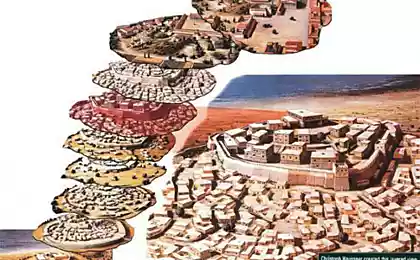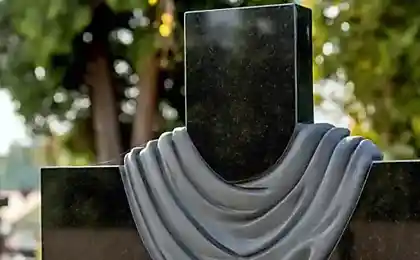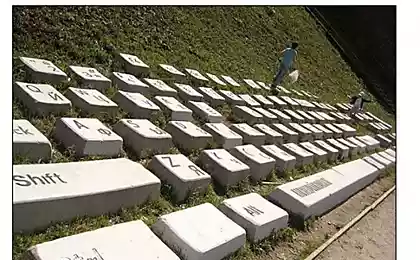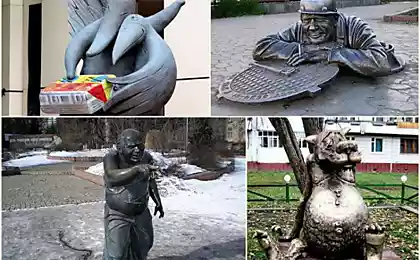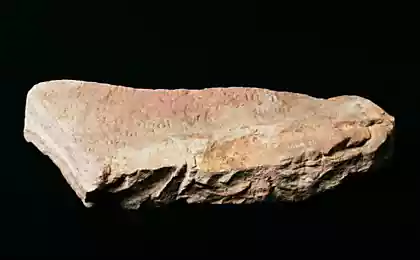1288
What we have managed to destroy
People love movies about the ancient Romans, Indians and other great civilizations, but few people think about preserving cultural and historical heritage of a bygone era. The barbaric destruction of the masterpieces of architecture, sculpture and mosaic can lead to the fact that the temples, tombs and pyramids will only scenery of Hollywood blockbusters.
When talking about the interests of corrupt officials and greedy corporations, everything else is forgotten. Of course, nothing lasts forever, and everything ever be destroyed, but to do it on purpose, for the sake of short-term profit - crime, especially to future generations, because as he said Vasily Klyuchevsky, people are not remembering his past, does not and future.
1. Troy
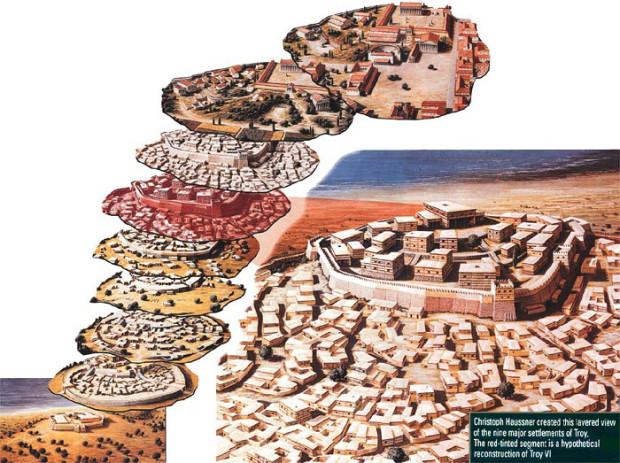
Until 1871, when amateur archaeologist Heinrich Schliemann discovered the ruins of the city, the scientists assumed that Troy - fiction writers and chroniclers of the ancient epics. To make a revolutionary discovery, Schliemann had to use explosive brainchild of Alfred Nobel - dynamite, causing a significant part of the heritage of the Trojans were destroyed.
2. The Buddhas of Bamiyan, Afghanistan
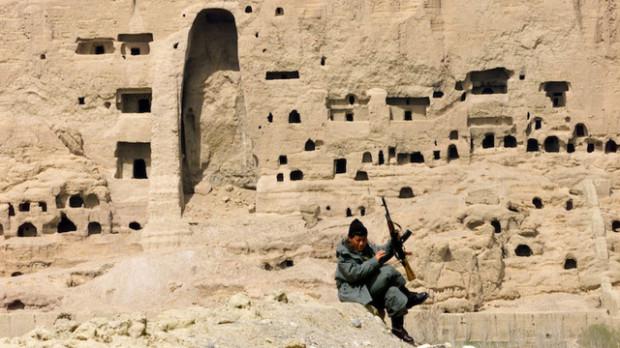
Two giant statues height of 37 meters and 55, were part of the temple complex of the Bamiyan Valley in Afghanistan, only a few years ago were known as a fine example of Buddhist ritual sculpture. Unfortunately, in March of 2001 the priceless statues were blown up by members of the radical group on the orders of the Taliban Mullah Mohammed Omar. UNESCO decided not to rebuild the sculpture of the high cost of the project.
3. Umm al-Akarib Iraq
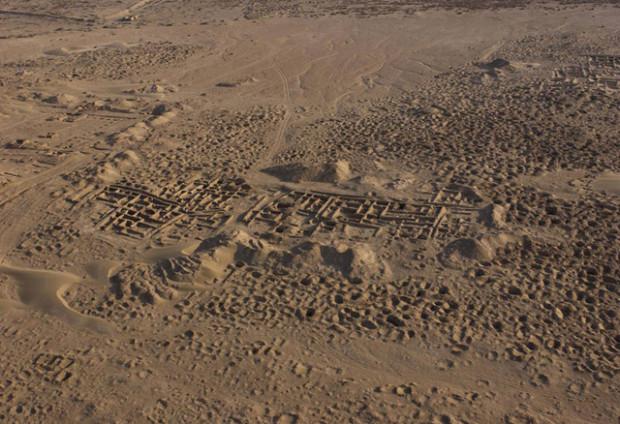
The cultural heritage of Iraq in the 1990s and early 2000s, suffered significant losses due to the unstable political and social situation, which forced the Iraqi Board of Antiquities take measures for the protection of historical and cultural monuments of the country by armed gangs of looters.
In May of 2003 a delegation to Iraq as part of the University of Chicago professor of archeology McGuire Gibson, Colonel John Kessel, Piero Cordone, the Italian diplomat and several military. After touring the ruins of Umm al-Akariba experts have concluded that the emergency measures can only save what geniuses of the Iraqi people have created over the centuries. Unfortunately, before the world community drew attention to the problem, many architectural structures have been lost forever.
4. The ruins of Babylon, Iraq
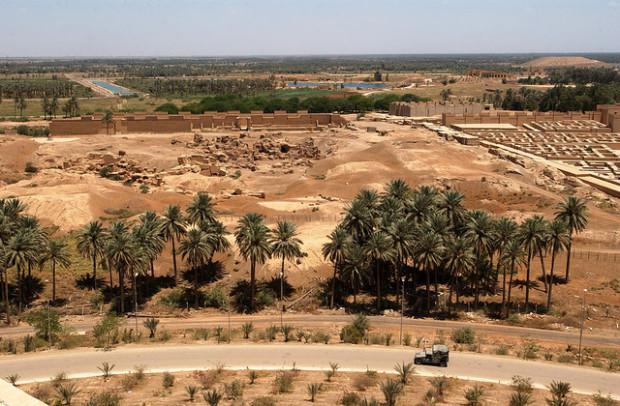
Officer John Curtis of the British Museum in his report two years ago told the world about the destruction of cultural and historical monuments during the military operation in Iraq.
On the territory of the ruins of Babylon area of approximately 150 hectares located camp of more than two thousand soldiers. Ancient bridge age of about 2, 5 thousand years, leading to the gate of Ishtar, was smashed by tanks, itself a unique monument of architecture has received significant damage, and rich on the archeological findings scattered bags of soil for the construction of fortifications. Caravanserai Khan Al RabaX century was used as a testing ground for the destruction of weapons and ammunition to the rebels, with the result that the building was almost completely destroyed.
5. Tomb of the Sixth Dynasty, the city of Nanjing, China

The grandiose burial structures erected, according to archaeologists from the Museum of Nanjing, between 220th and 589th years BC, constructed of green bricks, covered with images of lotus, and artfully decorated by engravings of Chinese masters.
The tombs were discovered in the year 2007 during the construction of the shopping center company «IKEA». Historians and archaeologists have demanded to stop construction on the time needed for excavation and study findings, however in their opinion no one listened: bulldozers and excavators fully destroyed the entire historic complex of buildings, and now this place is literally on the bones of the store.
Penalties for destruction of historical and cultural heritage in China are from ¥ 50 million to ¥ 500,000 (about $ 6, 6 thousand to $ 65, 7000), but the corruption and the pressure of large corporations lead to the fact that each year in China erases the ground a number of masterpieces of ancient architecture.
6. Historic Monuments in Chile and Argentina
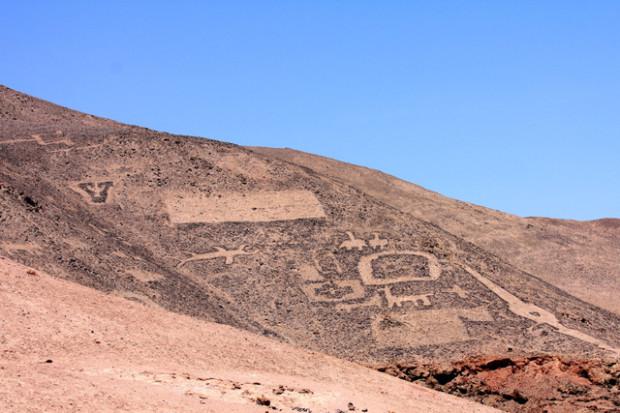
Transfer of the Dakar rally-marathon of 2009 in South America from Europe and Africa, has led to the destruction and damage to several archaeological structures in Chile and Argentina.
According to the report of the Council to Preserve National Monuments, four destroyed historic monuments located in the Atacama Desert and two in the region Kikimbo 500 km north of Chile's capital Santiago. Particular attention is paid to the Board of Pelican Creek, where scientists have discovered an ancient hunter-gatherer camp, half of which was destroyed during the race. Transport participants destroyed stone tools, including arrowheads and spears, scrapers and fragments of pottery, human remains and ruins of stone structures.
During the rally Sergio Cortes, one of the local activists advocating for preservation of the historical heritage of the country, he said that in the region of Tarapaca to the south of Iquique SUVs tourists were injured unique structures age 18 thousand years, known as geoglyphs Alto Yap.
In the Atacama Desert significant damage was also inflicted huge prehistoric images of animals, people, and geometric patterns made with stones and pebbles on the surface of the desert about five thousand years ago. Geoglyphs can be seen only with a bird's-eye view, so travelers often are not even aware that destroy historical monuments.
7. The ancient settlement of El Hibeh, about 288 km south of Cairo, Egypt
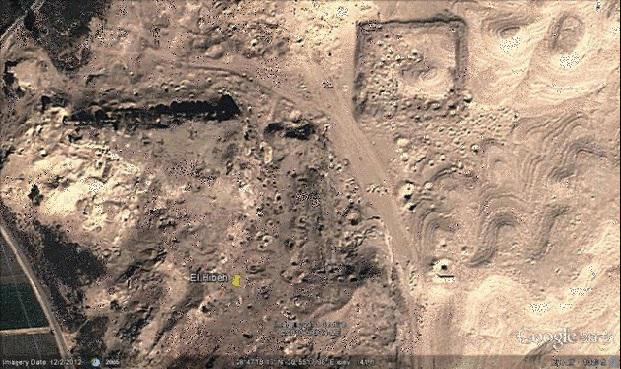
Excavations of the town of El Hibeh archaeologists from the University of California at Berkeley, was interrupted in 2009, the year and resumed three years later, however, scientists were disappointed - they found only a hundred tombs looted looters. Vandals desecrated many human remains and destroyed several buildings and stolen property soon "surfaced" in the "black market».
8. Historical and cultural monuments of Syria
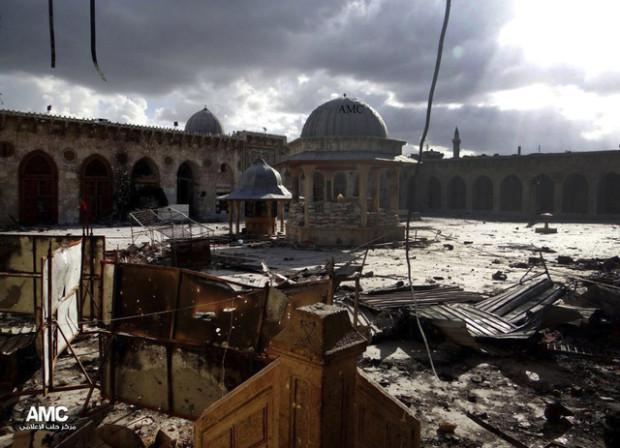
In recent years, the situation in Syria remains extremely tense: thousands of people died in the civil war, a huge part of the population fled the country, destroyed many architectural monuments, among them a mosque built XI-th century. Most of Aleppo, one of the oldest cities in the world, lies in ruins, and looted ruins of cities Ebla, Apamea, and many others. Scientists around the world are sounding the alarm: if in the near future the situation in the country stabilizes, almost all of Syria's cultural heritage will be irretrievably lost or looted.
9. The Mayan pyramid in Belize
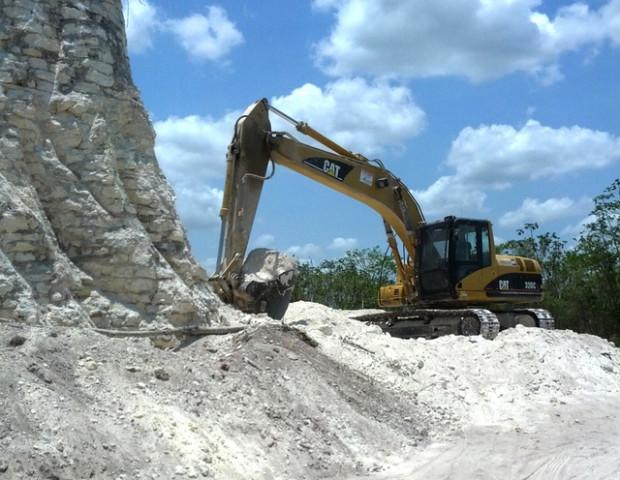
One of the greatest works of Mayan pyramid Noh Mul, erected about 2, 3 million years ago, was destroyed by bulldozers in the production of crushed stone for construction of roads. A unique masterpiece of ancient architects height of 30 meters, very popular among tourists, ceased to exist in May 2013.. The leaders of the construction company «D-Mar General Contracting and Development, Inc.», whose members are responsible for what happened, refrained from comment.
10. Pyramid at El Paraiso, Peru
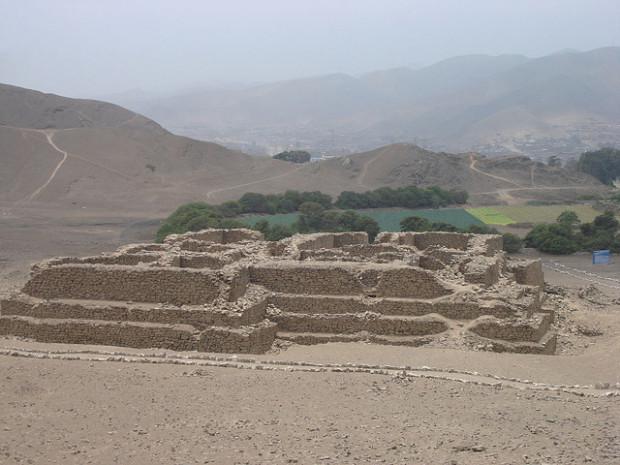
A small 6-meter pyramid, located near Lima, in June 2013. razed to the ground work of the two companies involved in the sale of real estate to make an elite land for development. Archaeologists claim that the construction of the age of about four thousand years was administrative and religious center of ancient civilization that existed here before the arrival of the Incas.
Unfortunately, the public were unable to prevent the destruction of priceless historical monument, so it remains to take measures to rescue the other objects of cultural heritage. Police stopped time workers who were going to carry the other three pyramids of the architectural complex, moreover, carried out an investigation of the company's employees.
11. Antinopolis, Egypt
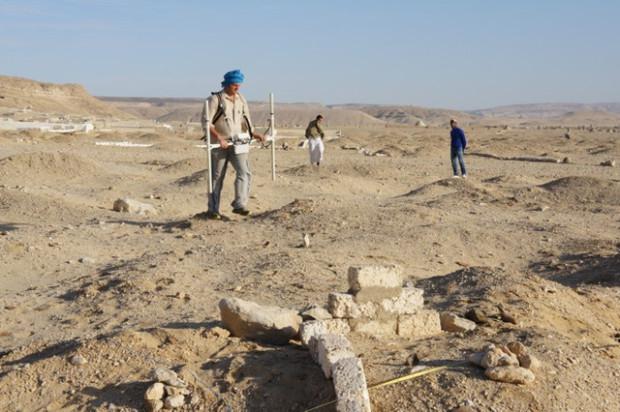
According to Monica Hannah, a researcher at the Berlin Humboldt University, Department of Antiquities of Egypt could not prevent the destruction of the ancient city Antinopolis, which was built on the left bank of the Nile by the Roman Emperor Hadrian in memory of his favorite Antinous, drowned here. Once Antinopolis was one of the cultural centers of the so-called Roman Egypt, and now in its place is situated settlement called Sheikh Ibad.
Most of the finest masterpieces of ancient architecture, including many schools, theaters and churches destroyed looters for several hundred years. If at the end of XVIII-th century, some of the buildings still exist, but now almost nothing left, but there still are papyri and other evidence of former prosperity Antinous.
source Your text to link ...
When talking about the interests of corrupt officials and greedy corporations, everything else is forgotten. Of course, nothing lasts forever, and everything ever be destroyed, but to do it on purpose, for the sake of short-term profit - crime, especially to future generations, because as he said Vasily Klyuchevsky, people are not remembering his past, does not and future.
1. Troy

Until 1871, when amateur archaeologist Heinrich Schliemann discovered the ruins of the city, the scientists assumed that Troy - fiction writers and chroniclers of the ancient epics. To make a revolutionary discovery, Schliemann had to use explosive brainchild of Alfred Nobel - dynamite, causing a significant part of the heritage of the Trojans were destroyed.
2. The Buddhas of Bamiyan, Afghanistan

Two giant statues height of 37 meters and 55, were part of the temple complex of the Bamiyan Valley in Afghanistan, only a few years ago were known as a fine example of Buddhist ritual sculpture. Unfortunately, in March of 2001 the priceless statues were blown up by members of the radical group on the orders of the Taliban Mullah Mohammed Omar. UNESCO decided not to rebuild the sculpture of the high cost of the project.
3. Umm al-Akarib Iraq

The cultural heritage of Iraq in the 1990s and early 2000s, suffered significant losses due to the unstable political and social situation, which forced the Iraqi Board of Antiquities take measures for the protection of historical and cultural monuments of the country by armed gangs of looters.
In May of 2003 a delegation to Iraq as part of the University of Chicago professor of archeology McGuire Gibson, Colonel John Kessel, Piero Cordone, the Italian diplomat and several military. After touring the ruins of Umm al-Akariba experts have concluded that the emergency measures can only save what geniuses of the Iraqi people have created over the centuries. Unfortunately, before the world community drew attention to the problem, many architectural structures have been lost forever.
4. The ruins of Babylon, Iraq

Officer John Curtis of the British Museum in his report two years ago told the world about the destruction of cultural and historical monuments during the military operation in Iraq.
On the territory of the ruins of Babylon area of approximately 150 hectares located camp of more than two thousand soldiers. Ancient bridge age of about 2, 5 thousand years, leading to the gate of Ishtar, was smashed by tanks, itself a unique monument of architecture has received significant damage, and rich on the archeological findings scattered bags of soil for the construction of fortifications. Caravanserai Khan Al RabaX century was used as a testing ground for the destruction of weapons and ammunition to the rebels, with the result that the building was almost completely destroyed.
5. Tomb of the Sixth Dynasty, the city of Nanjing, China

The grandiose burial structures erected, according to archaeologists from the Museum of Nanjing, between 220th and 589th years BC, constructed of green bricks, covered with images of lotus, and artfully decorated by engravings of Chinese masters.
The tombs were discovered in the year 2007 during the construction of the shopping center company «IKEA». Historians and archaeologists have demanded to stop construction on the time needed for excavation and study findings, however in their opinion no one listened: bulldozers and excavators fully destroyed the entire historic complex of buildings, and now this place is literally on the bones of the store.
Penalties for destruction of historical and cultural heritage in China are from ¥ 50 million to ¥ 500,000 (about $ 6, 6 thousand to $ 65, 7000), but the corruption and the pressure of large corporations lead to the fact that each year in China erases the ground a number of masterpieces of ancient architecture.
6. Historic Monuments in Chile and Argentina

Transfer of the Dakar rally-marathon of 2009 in South America from Europe and Africa, has led to the destruction and damage to several archaeological structures in Chile and Argentina.
According to the report of the Council to Preserve National Monuments, four destroyed historic monuments located in the Atacama Desert and two in the region Kikimbo 500 km north of Chile's capital Santiago. Particular attention is paid to the Board of Pelican Creek, where scientists have discovered an ancient hunter-gatherer camp, half of which was destroyed during the race. Transport participants destroyed stone tools, including arrowheads and spears, scrapers and fragments of pottery, human remains and ruins of stone structures.
During the rally Sergio Cortes, one of the local activists advocating for preservation of the historical heritage of the country, he said that in the region of Tarapaca to the south of Iquique SUVs tourists were injured unique structures age 18 thousand years, known as geoglyphs Alto Yap.
In the Atacama Desert significant damage was also inflicted huge prehistoric images of animals, people, and geometric patterns made with stones and pebbles on the surface of the desert about five thousand years ago. Geoglyphs can be seen only with a bird's-eye view, so travelers often are not even aware that destroy historical monuments.
7. The ancient settlement of El Hibeh, about 288 km south of Cairo, Egypt

Excavations of the town of El Hibeh archaeologists from the University of California at Berkeley, was interrupted in 2009, the year and resumed three years later, however, scientists were disappointed - they found only a hundred tombs looted looters. Vandals desecrated many human remains and destroyed several buildings and stolen property soon "surfaced" in the "black market».
8. Historical and cultural monuments of Syria

In recent years, the situation in Syria remains extremely tense: thousands of people died in the civil war, a huge part of the population fled the country, destroyed many architectural monuments, among them a mosque built XI-th century. Most of Aleppo, one of the oldest cities in the world, lies in ruins, and looted ruins of cities Ebla, Apamea, and many others. Scientists around the world are sounding the alarm: if in the near future the situation in the country stabilizes, almost all of Syria's cultural heritage will be irretrievably lost or looted.
9. The Mayan pyramid in Belize

One of the greatest works of Mayan pyramid Noh Mul, erected about 2, 3 million years ago, was destroyed by bulldozers in the production of crushed stone for construction of roads. A unique masterpiece of ancient architects height of 30 meters, very popular among tourists, ceased to exist in May 2013.. The leaders of the construction company «D-Mar General Contracting and Development, Inc.», whose members are responsible for what happened, refrained from comment.
10. Pyramid at El Paraiso, Peru

A small 6-meter pyramid, located near Lima, in June 2013. razed to the ground work of the two companies involved in the sale of real estate to make an elite land for development. Archaeologists claim that the construction of the age of about four thousand years was administrative and religious center of ancient civilization that existed here before the arrival of the Incas.
Unfortunately, the public were unable to prevent the destruction of priceless historical monument, so it remains to take measures to rescue the other objects of cultural heritage. Police stopped time workers who were going to carry the other three pyramids of the architectural complex, moreover, carried out an investigation of the company's employees.
11. Antinopolis, Egypt

According to Monica Hannah, a researcher at the Berlin Humboldt University, Department of Antiquities of Egypt could not prevent the destruction of the ancient city Antinopolis, which was built on the left bank of the Nile by the Roman Emperor Hadrian in memory of his favorite Antinous, drowned here. Once Antinopolis was one of the cultural centers of the so-called Roman Egypt, and now in its place is situated settlement called Sheikh Ibad.
Most of the finest masterpieces of ancient architecture, including many schools, theaters and churches destroyed looters for several hundred years. If at the end of XVIII-th century, some of the buildings still exist, but now almost nothing left, but there still are papyri and other evidence of former prosperity Antinous.
source Your text to link ...



